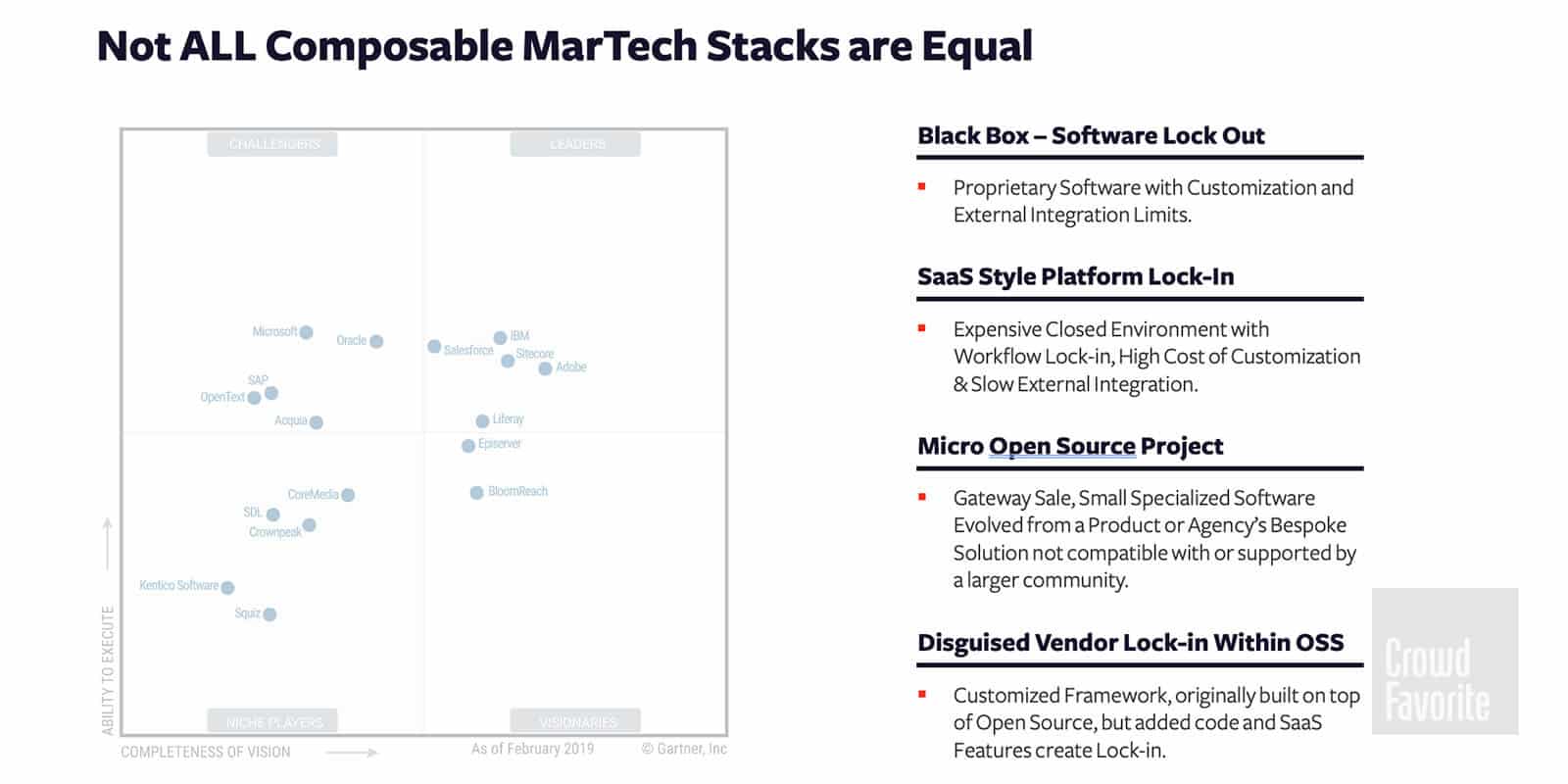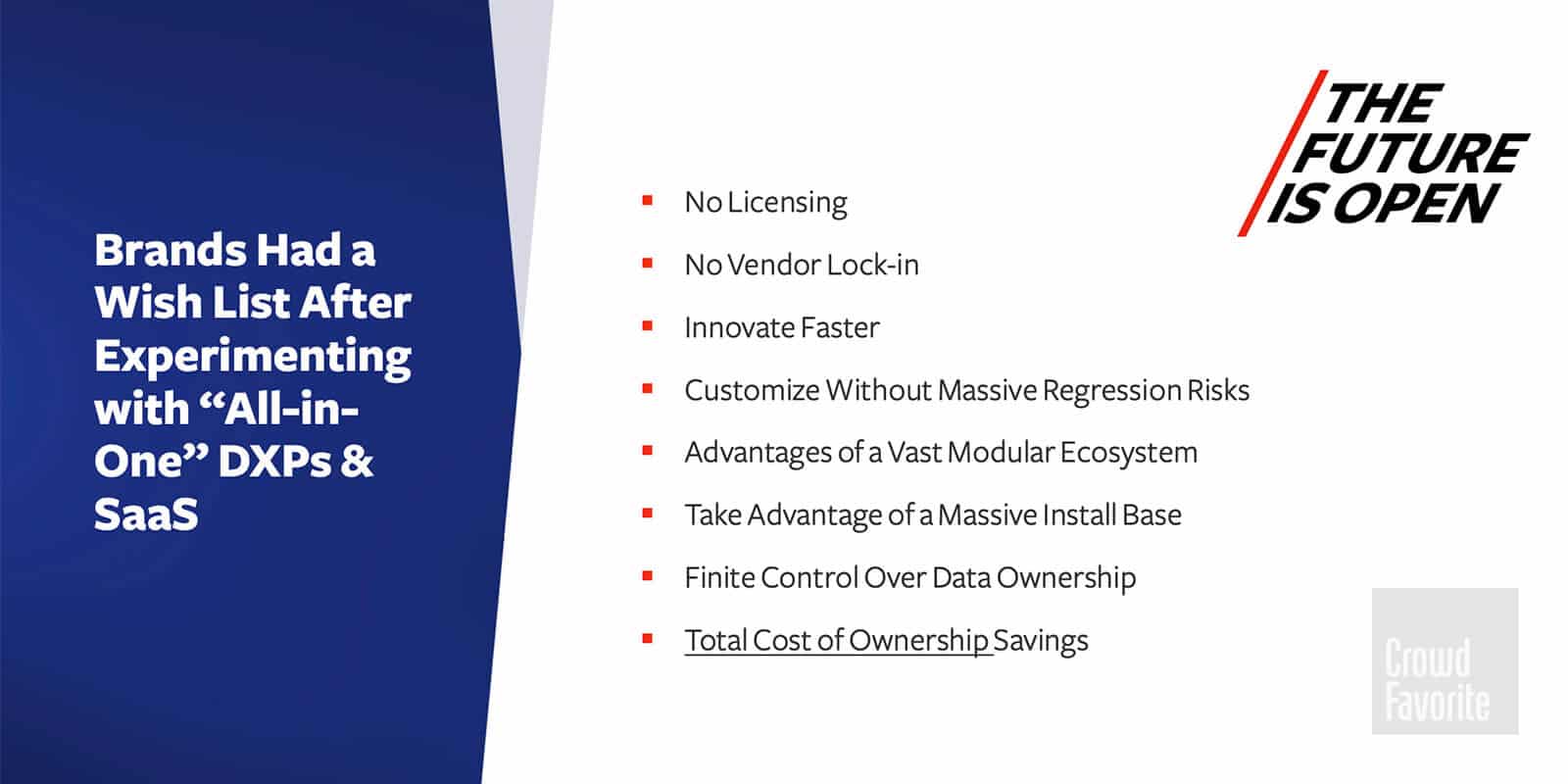Karim Marucchi, CEO of Crowd Favorite, and James Rutherford, Director, Global and Technology Partnerships at Pantheon Platform, spoke to marketers at Digital Summit, Phoenix about successful MarTech tactics that major brands are using to achieve their marketing goals.
In this article you will learn:
Digital Summit Phoenix
Download the full presentation!
- How to create a successful MarTech strategy by prioritizing marketing goals and use cases over chasing the latest technology.
- Why Closed Source Digital Experience Platforms (DXPs) can lead to high costs and slow implementation, hindering your website’s performance and KPI achievements.
- Why Open Source solutions such as WordPress, offer cost-efficiency, agility, and true Omnichannel experiences.
- How to embrace automation to streamline processes, boost efficiency, and leverage Open Source technology to stay competitive in the digital landscape.
Thinking Beyond Features for Marketing Success
As a marketer, you know that in today’s digital age, building a website and implementing digital marketing tactics is no longer enough. It’s crucial to think beyond technical features and consider how your business use cases and marketing goals can be achieved through the right strategies. It’s important not to lose sight of the bigger picture in order to chase after the latest technology.

Clients often approach agencies and only ask for certain features, such as personalization. But the companies that can articulate their use case, and what they are trying to solve are the ones that are most successful. That is because these organizations are thinking operationally, and how to achieve their digital marketing goals, rather than just purchasing features.
The customer should always be at the center of any digital marketing strategy, and companies should be centered around the message they want to convey, rather than a specific technology stack. However, in recent years, there has been a rush toward Closed Source DXPs, such as Adobe Experience Manager, with the assumption that this will solve all their problems.
32 Innovative MarTech Stacks
The most successful brands consider their customers, organizational workflow, and marketing goals before they design their MarTech Stack. View a sampling of some of the most successful MarTech stacks.
Not all Composable MarTech Stacks are Equal
The challenge with thinking that one software will solve all your problems is that organizations forget to look at how they will implement this technology in a way that makes sense to their customers and internal teams. Whether using a proprietary system or building it themselves, the total cost of ownership (TCO) goes through the roof and the editorial experience is usually the first budget item to go, causing a tremendous amount of pain.

Organizations that have invested in market-leading or proprietary DXPs still struggle to make changes quickly. Some can take weeks to make simple updates to their website, rendering their investment in technology useless. This rush to create Omnichannel experiences has led to 15% of customers reporting that their website is functionally broken, and only 15% are meeting all their KPIs for their business.
Raising the Digital Innovation Bar
This creates a situation where the bar for what is considered good for digital marketers is lower than what they can actually compete with in terms of innovation. The highest-performing teams ask, “How can we create great content that’s actually going to impact our users?” “How fast can our internal teams leverage this platform to actually drive change.” Successful marketing teams also release content continuously which empowers them to raise the bar for their most important channel, their website.
To achieve this, organizations need to develop use cases across the entire organization and focus on what their needs are, rather than just buying technology for the sake of it. They need to empower their teams to make changes quickly based on that data.

This can only be done with an Open Source DXP. WordPress has been a popular platform for building websites and managing content for years. However, many organizations are using it in the same way they did years ago, simply adding new modules and plugins. We need to change the way marketers think about using Open Source products like WordPress. We need to start thinking about using Open Source software as the core. Once marketers master this concept, they are no longer pushing content on a brochureware site, instead, they are delivering a true Omnichannel experience.
Open Source MarTech
Success Stories
See how Crowd Favorite helped our clients Emmys, Nvidia, and Academic Partnerships successfully leverage Open Source to deliver a true Omnichannel experience.
Marketers need to move from pushing content on a brochureware site to delivering a true Omnichannel experience.
– Karim Marucchi
Empowering Organizations with WordPress
By choosing WordPress, organizations are able to become more efficient while lowering their total cost of ownership. Companies can hire content editors who are able to hit the ground running with WordPress on the very first day and be extremely effective, bringing value to the investment.
Other advancements in technology have made it possible for teams to collaborate more effectively on the web. Instead of passing Photoshop designs back and forth, tools like Figma, allow everyone to work and collaborate together in the same digital space. At the same time, technology has solved many of the problems organizations used to face, such as security and bug fixes, making it easier for marketers to focus on driving traffic and creating campaigns.

Marketers should also constantly review what they do, identify what is automatable, and make that part of their roadmap to boost efficiency. With the technology available today, it is possible for organizations to achieve their visions and plans more easily than ever before. The key is to embrace new technologies and approaches, such as leveraging Open Source products, like WordPress, and automating as much as possible.
Ready to find out more?
Interested in learning how Open Source-based DXPs can help simplify and streamline workflow complexity? Contact the team at Crowd Favorite, we’d love to sit down and discuss solutions!

If you’re a marketer and want to learn how to implement this change and decrease your Workflow Level of Effort. Check out our new article Streamline your Marketing Editorial Workflow.
Follow us on LinkedIn and Twitter to make sure you don’t miss more relevant content.





